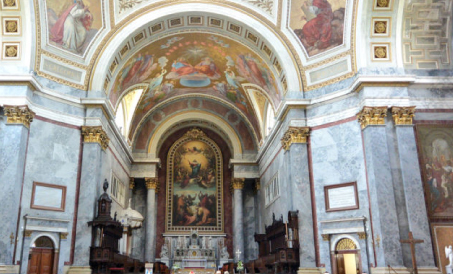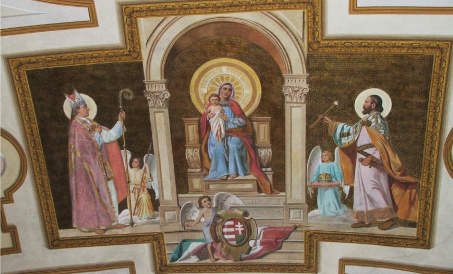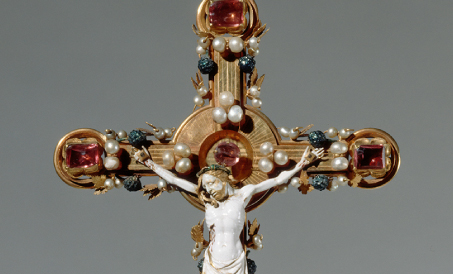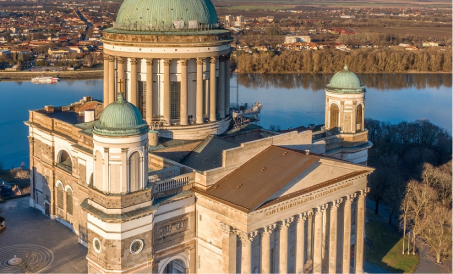The first exhibition was opened in the vault opening from the liturgical space, where today the guest can find a relic exhibition and a shop of devotional objects. In addition to the artefacts that were once used and survived in the cathedral, many pieces were purchased by the founder and other donators, so the collection constantly enriched. In 1987, a new, permanent exhibition of the Treasury was opened on the first floor on the west side. Since 2020, goldsmiths' works and textiles of the liturgical ceremonies can be viewed in modern showcases and air-conditioned halls.
The oldest pieces in the exhibition are the oval rock crystal made in Metz in the ninth century, in which a scene from Calvary is engraved, and the staurothec, i.e. the enamelled, Byzantine icon from the beginning of the XIII century, which preserves the shards of the cross of Jesus.
It was the privilege of the current archbishop of Esztergom to anoint and crown the kings of Hungary. The treasury of Esztergom preserves the liturgical textiles and goldsmiths' works used during coronations. The earliest of them is the coronation oath cross, which was made of gold and jewels at the end of the XIII. century. Its stem button and sole were renewed by Cardinal Péter Pázmány in 1634, and from then on this cross was certainly used only at coronations. The high priest's inventory of the king's coronation includes the bishop's hat covered with pearls from the 15th century and the pastoral staff of Archbishop Miklós Oláh (11553-1568). The baroque vestment with pearl embroidery was worn since the coronation of King Leopold II. (in 1790). In the coronation display case of the permanent exhibition, we can see the liturgical relics used or worn by the archbishop at the time of the last royal coronation in 1916.
Originally, the horn goblets mentioned in the Treasury's inventory of 1528 were ornaments for secular purposes. The two horn goblets, made around 1400, belonged to IV Wenceslas, king of Bohemia (1378-1419), and have passed from his treasury to King Sigismund of Hungary (1387-1437), who presumably bequeathed the horn goblets to György Pálóci, archbishop of Esztergom (1423-1439). According to tradition, the third drinking vessel, made around 1480, was a gift to the treasury by the illegitimate son of King Matthias (1458-1490), János Corvinus. In the horn goblets sacred oils were held.

The most valuable piece of the treasury is the Matthias Calvary, made of about 5 kg of gold. Its Gothic upper part was made in Paris and given by Margaret of Flanders to her husband Philip the Bold in 1403. Instead of its original pedestal, at the end of the fifteenth century, perhaps in the workshop of an Italian goldsmith in Buda, a new one was made, decorated with the coat of arms of King Matthias (1458-1490). Matthias may have owned the Calvary between 1469 and 1490. After the death of the king, his illegitimate son, János Corvin, pledged the Calvary to Tamás Bakócz, who was the archbishop of Eger at the time, in 1494. Tamás Bakócz, archbishop of Esztergom (1497-1521), bequeathed the Calvary to the altar of his own funeral chapel in Esztergom, which still stands today.
One of the outstanding monuments of medieval Hungarian goldsmithing is the wire enamel chalice made in Transylvania around 1437-1440, which was donated to the cathedral of Alba Iulia by Transylvanian nobleman Benedek Suki. In 1557 Bishop István Ilosvai took him to Trnava, where the archdiocese and chapter of Esztergom were staying at that time, from where he was later transferred to the treasury of Esztergom. A total of thirty niches on the sole, stem and button feature finely crafted miniature statuettes of Mary, Christ the Blesser, and saints and angels. On the basket of the chalice are depicted in six round medallions the Annunciation, the Adoration of Kings, Mary with the Child, Calvary, Pieta and Christ of Sorrow.
Imre Esterházy's gentleman's pointer and chalice made in Vienna are examples of Baroque goldsmithing, as are Charles Ambrus's chalice and jugs made in Augsburg. In 1729, Primate Imre Esterházy donated the monstrance, which was made in the goldsmith's workshop of Georg Caspar Meichl in Vienna, to the Treasury, . From the rich ecclesiastical equipment of Archbishop Charles Ambrus Habsburg (1808-1809), the chalice and jugs made by Johann Jacob Vogelhund, goldsmith from Augsburg, are worth highlighting with the accompanying tray.
In the nineteenth century, the stock of the treasury was expanded by significant donations from the four archbishops who built the cathedral and from the members of the chapter. Through the art trade and purchases of Archbishop János Simor and the incorporation of the legacy of Arnold Ipolyi, Bishop of Oradea, the outstanding permanent collection exhibition was formed.
The Treasury preserves the historicist wire enamelled pastoral staff donated by the city of Budapest in 1886 on the occasion of János Simor's Golden Mass. The art collector completed the historical overview of the presentation of the treasury by purchasing medieval and modern objects.
From the legacy of the canons of Esztergom, bust crosses, chalices, rings from the 19th and 20th centuries can be seen in the last phase of the permanent exhibition. The historical presentation is closed by the objects of János Csernoch, Jusztinián Serédi and József Mindszenty.








